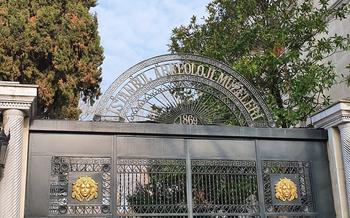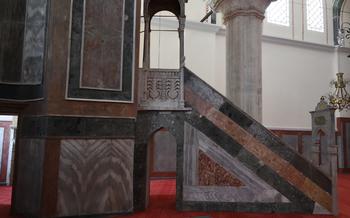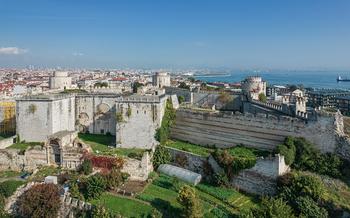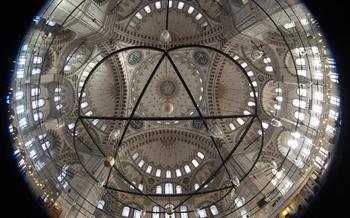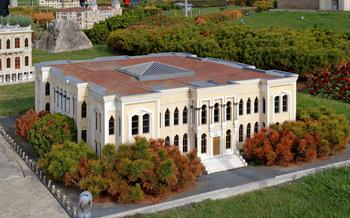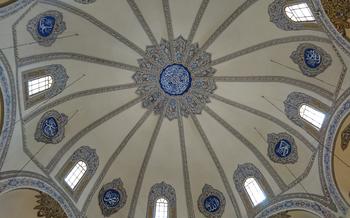
Topkapi Palace
- Topkapi Palace: A Majestic Legacy
- The Imperial Gate: A Grand Entrance
- The First Courtyard: A Place of Ceremonies
- The Second Courtyard: A Center of Administration
- The Third Courtyard: A Realm of Private Quarters
- The Fourth Courtyard: A Place of Entertainment
- The Imperial Kitchens: A Culinary Haven
- The Topkapi Palace Museum: A Treasure Trove of Artifacts
- Gülhane Park: A Serene Oasis
- The Archeological Museum: A Journey Through History
- The Museum of Turkish and Islamic Arts: A Cultural Tapestry
- The Chora Church: A Byzantine Masterpiece
- The Süleymaniye Mosque: A Symbol of Ottoman Architecture
- Insider Tip: Exploring the Palace Like a Local
Topkapi Palace: A Majestic Legacy
The Topkapi Palace stands as a testament to the grandeur and opulence of the Ottoman Empire. Built in the 15th century, it served as the residence of Ottoman sultans for over four centuries, witnessing the rise and fall of one of the world's most powerful empires. Explore its rich history, admire its stunning architecture, discover its fascinating collection of artifacts, and soak in the breathtaking vistas from its terraces, as you journey through the legacy of the Topkapi Palace.
The Imperial Gate: A Grand Entrance
As you approach the Topkapi Palace, your gaze will be drawn to the imposing Imperial Gate, also known as the Bâb-ı Hümâyûn. This grand entrance served as the main gateway for the sultan and his entourage, welcoming them into the palace's opulent domain. The gate's architectural features are a testament to the refined artistry of the Ottoman era. Admire the intricate tilework adorning the archway, the decorative niches housing elegant fountains, and the imposing towers that flank the gate, exuding an aura of power and grandeur.
Within the gate, a small museum awaits, showcasing artifacts that provide a glimpse into the palace's rich history. Discover fascinating objects related to the gate's function and the lives of those who passed through it. Don't miss the opportunity to capture stunning photographs of the gate and its surroundings from the nearby park, where you can take a moment to appreciate the grandeur of this architectural masterpiece before venturing further into the palace grounds.
The First Courtyard: A Place of Ceremonies
The First Courtyard of the Topkapi Palace holds immense historical significance as it served as a space for official ceremonies, gatherings, and celebrations during the Ottoman era. This vast courtyard, with its impressive size and elegant arcades, hosted a variety of events, including imperial processions, festivals, and religious ceremonies.
Architectural Features:
The First Courtyard showcases stunning architectural features that reflect the grandeur of the Ottoman Empire. Its impressive size and symmetrical layout create a sense of awe and grandeur. The courtyard is surrounded by elegant arcades supported by slender columns, creating a harmonious and visually appealing space. The monumental gates that lead to the subsequent courtyards are adorned with intricate carvings and decorative elements, adding to the overall splendor of the courtyard.
Museum Exhibits:
Within the First Courtyard, visitors can explore the Archaeological Museum, which houses a fascinating collection of artifacts from various periods of Turkish history. These exhibits provide insights into the rich cultural heritage of the region and showcase the diverse influences that have shaped Istanbul over the centuries. From ancient pottery and sculptures to coins and jewelry, the museum offers a glimpse into the past and helps visitors understand the historical significance of the Topkapi Palace.
Practical Tip:
Take a moment to relax and soak in the serene atmosphere of the First Courtyard. Find a shady spot under one of the arcades and enjoy the tranquility of the surroundings. Let the beauty of the architecture and the historical significance of the courtyard transport you back in time to the days when the Ottoman Empire flourished.
The Second Courtyard: A Center of Administration
The Second Courtyard of the Topkapi Palace served as the administrative heart of the Ottoman Empire. It was here that the sultan conducted official business and received foreign dignitaries. The courtyard is dominated by the Divan building, where the Imperial Council met to discuss matters of state. The Treasury, located in the same courtyard, housed the empire's vast wealth, including gold, silver, and jewels. The Imperial Council Chamber, where the sultan held private meetings with his advisors, is also located in this courtyard.
The Second Courtyard is a testament to the Ottoman Empire's administrative prowess. Its grand architecture and impressive size reflect the power and authority of the sultan. Visitors to the palace can explore the various buildings in this courtyard and learn about the intricate workings of the Ottoman government.
Practical Tip: Join a guided tour of the Second Courtyard to gain insights into the administrative functions that took place in this important part of the palace. Tours are available in multiple languages and provide a deeper understanding of the Ottoman Empire's political and economic systems.
The Third Courtyard: A Realm of Private Quarters
The third courtyard of the Topkapi Palace was a private haven reserved for the sultan and his family. Unlike the other courtyards, which were open to officials and visitors, this courtyard was strictly off-limits to outsiders. It was here that the sultan and his family lived, entertained, and conducted their personal affairs.
The third courtyard is home to several beautifully decorated pavilions, gardens, and fountains. The most notable of these is the Harem, the former living quarters of the sultan's wives and concubines. The Harem is a vast complex of buildings, courtyards, and chambers, each with its own unique purpose. Visitors can explore the Harem and learn about the lives of the women who lived there.
Another highlight of the third courtyard is the Sofa Pavilion, where the sultan would receive his closest advisors and confidants. The pavilion is decorated with exquisite tiles, intricate carvings, and stunning views of the Bosphorus Strait. Visitors can imagine the sultan holding court in this magnificent setting, surrounded by his most trusted advisors.
The third courtyard is a fascinating glimpse into the private lives of the Ottoman sultans. It is a place where history and intrigue intertwine, creating a captivating and unforgettable experience for visitors.
Practical tip: Pre-book your tickets for the Harem to avoid long queues, especially during peak tourist season.
The Fourth Courtyard: A Place of Entertainment
The fourth courtyard of the Topkapi Palace was a place of entertainment and leisure activities for the sultan and his court. It featured elegant pavilions, beautifully landscaped gardens, and the famous Baghdad Kiosk, a stunning example of Ottoman architecture. The courtyard was used for a variety of events, including lavish feasts, musical performances, and poetry recitals.
Architectural Features: Admire the courtyard's graceful pavilions, each decorated with intricate tilework, colorful frescoes, and elegant furnishings. The gardens are a delight to explore, with their vibrant flowers, fragrant plants, and shady trees. The Baghdad Kiosk, located at the center of the courtyard, is an architectural masterpiece with its ornate dome, delicate arches, and stunning views of the Bosphorus Strait.
Museum Exhibits: The courtyard houses a collection of artifacts related to court entertainment, including musical instruments, costumes, and other objects used during festivities. Visitors can learn about the types of music and dance that were popular during the Ottoman era and see examples of the elaborate costumes worn by performers.
Practical Tip: Take advantage of the audio guide available in multiple languages to enhance your visit. The audio guide provides detailed information about the history, architecture, and exhibits of the fourth courtyard, allowing you to fully appreciate its significance and immerse yourself in the vibrant atmosphere of Ottoman court life.
The Imperial Kitchens: A Culinary Haven
At the heart of the Topkapi Palace lies a culinary wonderland known as the Imperial Kitchens. This vast complex, once responsible for feeding the sultan and his entourage, offers a glimpse into the rich gastronomic traditions of the Ottoman Empire. Explore the well-preserved kitchens, including the grand domed hall, storage rooms, and ovens, and discover the secrets behind the elaborate feasts that graced the palace tables. Admire the collection of copper pots, pans, and other cooking utensils, which have witnessed centuries of culinary artistry. Combine your visit with a culinary tour to sample traditional Ottoman dishes inspired by the palace kitchens, tantalizing your taste buds with flavors that have stood the test of time.
The Topkapi Palace Museum: A Treasure Trove of Artifacts
The Topkapi Palace Museum stands as a testament to the rich history and cultural heritage of the Ottoman Empire. The museum, housed within the former imperial palace, offers visitors a glimpse into the opulent lifestyle of the sultans and the vast collections they amassed during their reign.
As you step into the museum, you are greeted by a stunning display of artifacts, each telling a unique story about the palace's past. Admire the exquisite jewelry, adorned with precious stones and intricate designs, that once adorned the sultans and their wives. Marvel at the collection of textiles, showcasing the finest craftsmanship of the Ottoman Empire, with vibrant colors and intricate patterns.
Delve into the world of Islamic art through the museum's collection of manuscripts, illuminated with beautiful calligraphy and intricate illustrations. Discover the history of weaponry through the display of swords, daggers, and armor, showcasing the military prowess of the Ottoman Empire.
Take your time to explore the museum's vast collection, as each artifact holds its own significance. Whether you are a history buff, an art enthusiast, or simply someone curious about the Ottoman Empire, the Topkapi Palace Museum offers a truly immersive and educational experience.
Gülhane Park: A Serene Oasis
Historical Significance:
Gülhane Park, located adjacent to the Topkapi Palace, holds historical significance as the former outer gardens of the palace. During the Ottoman period, these gardens were reserved for the exclusive use of the sultan and his entourage. In the 19th century, the gardens were opened to the public, becoming one of Istanbul's first public parks.
Architectural Features:
Gülhane Park is a tranquil oasis amidst the bustling city. Its beautifully landscaped gardens, adorned with colorful flowers, lush trees, and serene fountains, offer a peaceful escape from the urban chaos. Visitors can stroll along the park's winding paths, relax on benches under the shade of trees, or enjoy a picnic in the designated areas.
Museum Exhibits:
Within Gülhane Park, visitors can find two significant museums: the Museum of Islamic Art and the Museum of Turkish and Islamic Arts. The Museum of Islamic Art houses a collection of Islamic artifacts from various periods and regions, including ceramics, textiles, metalwork, and manuscripts. The Museum of Turkish and Islamic Arts, on the other hand, focuses on Turkish and Islamic art and culture, showcasing a diverse collection of carpets, textiles, ceramics, and other artifacts.
Practical Tip:
Pack a picnic lunch and enjoy a relaxing break in the park's serene surroundings. Spread out a blanket on the grass, savor the delicious food, and soak in the tranquil atmosphere of Gülhane Park, a hidden gem that offers a respite from the city's hustle and bustle.
The Archeological Museum: A Journey Through History
Within the walls of the Topkapi Palace, the Archeological Museum stands as a testament to Istanbul's rich and diverse history. Housing a vast collection of artifacts from civilizations that have shaped this vibrant city, the museum offers a journey through time, unveiling the secrets of ancient cultures.
Admire the museum's impressive neoclassical architecture, a testament to the enduring legacy of the 19th century. Inside, discover a treasure trove of ancient treasures, curated to showcase the diverse artistic expressions of civilizations such as the Hittites, Assyrians, and Greeks.
Explore mesmerizing sculptures that tell tales of forgotten empires, marvel at intricate pottery that reveals the daily lives of ancient peoples, and uncover exquisite jewelry that speaks to the craftsmanship of bygone eras. Each artifact whispers stories of cultural exchange, artistic innovation, and the interconnectedness of civilizations.
Take advantage of the museum's guided tours, led by knowledgeable experts who bring to life the significance of the exhibits. Immerse yourself in the narratives of ancient civilizations, gaining insights into their beliefs, customs, and artistic traditions.
Whether you're a history buff, an art enthusiast, or simply curious about the roots of Istanbul's rich cultural tapestry, the Archeological Museum promises an enriching and enlightening experience.
The Museum of Turkish and Islamic Arts: A Cultural Tapestry
The Museum of Turkish and Islamic Arts, housed in the historic Ibrahim Pasha Palace, is a treasure trove of Islamic art and culture. Its collection spans centuries and includes a diverse range of artifacts from Turkey, the Middle East, and North Africa. Visitors can explore galleries dedicated to carpets, textiles, ceramics, manuscripts, and other artworks, showcasing the rich artistic traditions of the Islamic world.
The museum's architecture is a blend of traditional Ottoman and modern elements, creating a stunning backdrop for the exhibits. Intricate tilework, elegant arches, and spacious halls add to the museum's charm and provide a glimpse into the architectural heritage of the region.
Tip: Join a workshop or demonstration offered by the museum to gain hands-on experience in traditional Turkish arts and crafts. Learn the art of calligraphy, carpet weaving, or pottery, and create your own unique souvenir to take home.
The Chora Church: A Byzantine Masterpiece
Within the historic neighborhood of Fatih, nestled amidst the bustling streets of Istanbul, lies a hidden gem of Byzantine art and architecture: the Chora Church, also known as the Kariye Museum. Step into this sacred space, and you will be transported back in time to the grandeur of the Byzantine Empire.
Admire the church's stunning architecture, characterized by its intricate mosaics that adorn the walls and ceilings. The mosaics depict biblical scenes, historical events, and portraits of saints, offering a glimpse into the rich visual culture of Byzantium. Marvel at the vibrant colors and detailed craftsmanship that bring these stories to life.
Explore the collection of religious artifacts and icons housed within the church, providing insights into Byzantine religious practices. Discover the significance of the iconostasis, a screen that separates the sanctuary from the nave, adorned with beautifully painted icons.
To fully appreciate the serene atmosphere of the Chora Church, visit early in the morning or late in the afternoon, when the crowds are fewer. Take your time to wander through the church, immersing yourself in the beauty of its mosaics and the tranquility of its surroundings.
The Süleymaniye Mosque: A Symbol of Ottoman Architecture
The Süleymaniye Mosque stands as a testament to the grandeur and artistry of Ottoman architecture. Commissioned by Sultan Süleyman the Magnificent and designed by the renowned architect Mimar Sinan, the mosque was completed in 1557 and remains one of the most iconic landmarks of Istanbul.
Admire the mosque's stunning architecture, characterized by its massive central dome, four slender minarets, and intricate tilework. The interior of the mosque is equally impressive, with a vast prayer hall adorned with elegant columns, arches, and stained-glass windows.
Take advantage of the opportunity to visit the mosque's museum, which houses artifacts related to its history and construction, including models, calligraphy, and tiles. Climb to the mosque's terrace for panoramic views of Istanbul, offering a breathtaking perspective of the city's skyline, including the Golden Horn and the Bosphorus Strait.
Whether you are a devout Muslim or simply a traveler seeking to appreciate the beauty of Islamic architecture, the Süleymaniye Mosque is a must-visit destination in Istanbul.
Insider Tip: Exploring the Palace Like a Local
To fully immerse yourself in the local culture and avoid the tourist crowds, consider visiting the Topkapi Palace during the shoulder seasons (April-May and September-October) or even during the winter months (November-March). While the weather may be cooler, you'll be rewarded with a more intimate and authentic experience. Take advantage of this time to engage with the friendly locals, who are always eager to share their stories and insights about the palace and its history. Remember to dress respectfully, covering your shoulders and knees, as the palace is a sacred site for many. Embrace the opportunity to savor the local cuisine by trying traditional Turkish dishes at one of the many restaurants or cafés in the surrounding area. By immersing yourself in the local culture, you'll gain a deeper appreciation for the Topkapi Palace and its enduring legacy.
